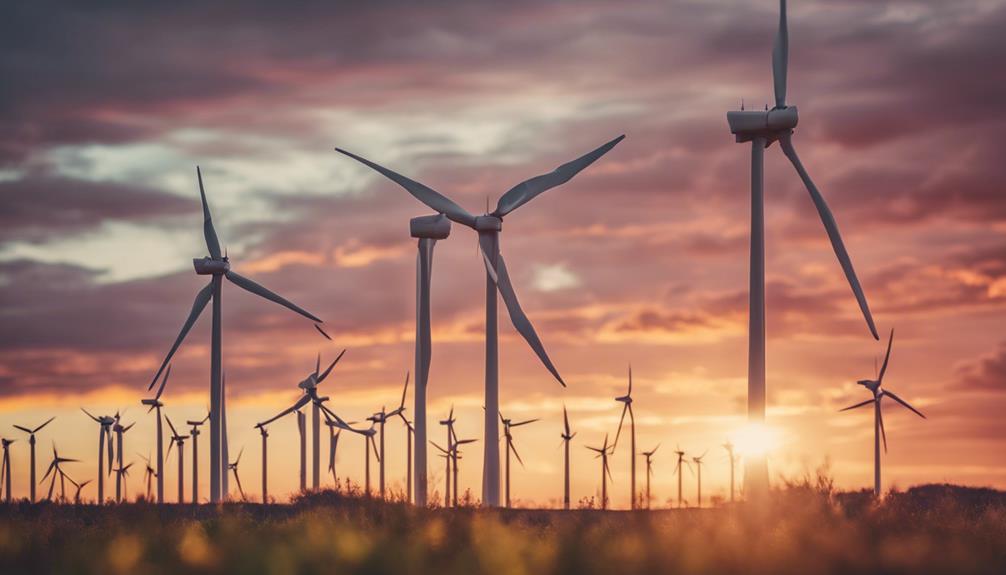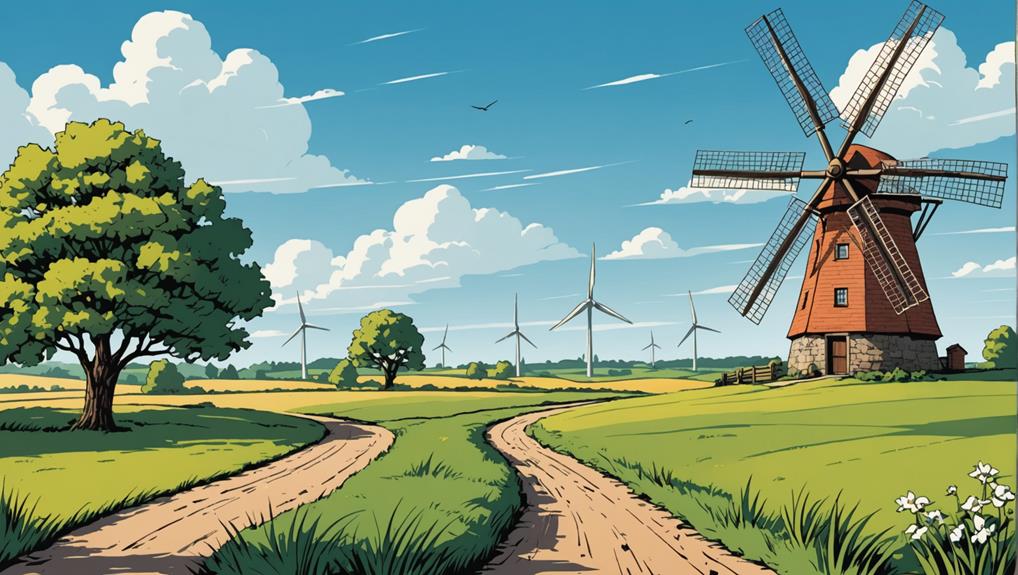Discover the remarkable wind turbine evolution, starting from ancient windmills to today's massive structures standing over 320 feet tall. These turbines boast intricate systems and thousands of parts, highlighting a shift towards sustainability and efficiency. Early civilizations harnessed wind's power for grinding grain and water pumping, a far cry from the electricity-generating giants of today. The U.S. wind industry employs over 125,000 individuals, with offshore wind farms offering faster, more consistent winds. With over 144,000 MW of wind capacity installed, the wind industry is a pivotal player in the energy mix. Explore more fascinating wind energy insights!
Key Takeaways
- Modern wind turbines average 320 feet in height.
- Rotor diameter has increased by 173% since 1998.
- Blades on turbines are about 210 feet long.
- Capacity of installed turbines in 2022 is 3.2 MW.
- Evolution showcases sustainability and effectiveness.
Evolution of Wind Turbines
Since the late 1990s, wind turbines have undergone significant growth and transformation regarding size and power output. The evolution of wind turbines has been marked by an increase in height, with towers now averaging over 320 feet tall. This height is vital for accessing higher wind speeds, which in turn boosts the efficiency of energy generation.
The average rotor diameter has surged by 173% since 1998-1999, contributing to improved efficiency. Modern wind turbines boast impressive blades that are, on average, 210 feet long, enabling them to capture more wind energy. Additionally, the average capacity of installed turbines in 2022 reached 3.2 MW, showcasing the trend of turbines becoming more powerful.
These advancements in height, efficiency, and power output highlight the continuous evolution of wind turbines towards greater sustainability and effectiveness in harnessing clean energy sources.
Wind Energy History
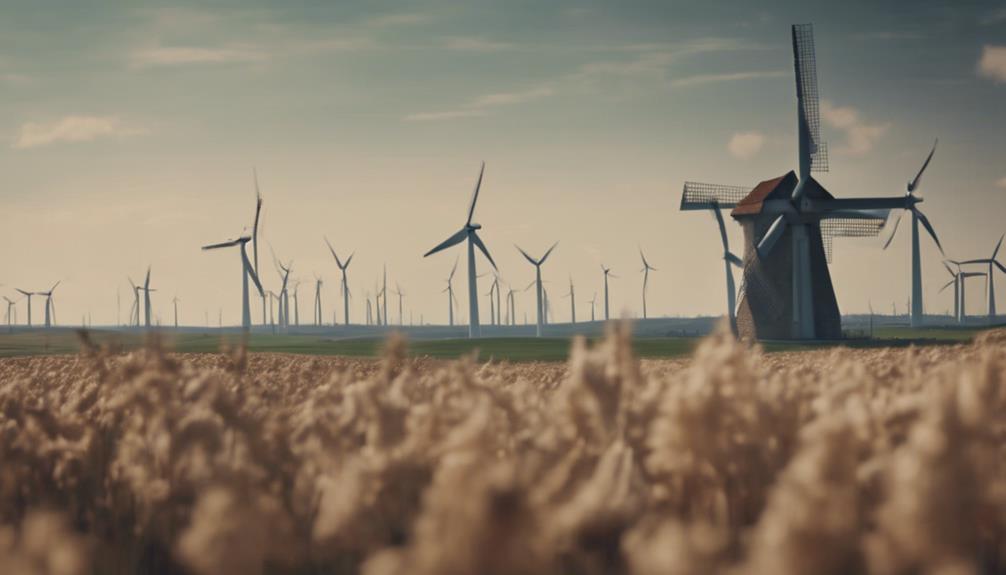
You've likely heard about how human civilizations have harnessed wind power for centuries, using early windmills for essential tasks.
These structures have come a long way since then, evolving into the complex turbines that generate electricity today.
The history of wind energy is a fascinating journey that showcases the evolution from basic windmills to the advanced turbines we rely on for modern electricity generation.
Early Wind Power
Early civilizations harnessed the power of wind through simple windmills, using them for tasks like grinding grain and pumping water. These traditional windmills laid the foundation for early wind power, showcasing the ingenuity of ancient societies in utilizing natural resources.
Unlike the sophisticated wind energy technology of today, these early windmills were basic in design but highly functional, serving essential purposes in daily life.
Over time, as technology advanced, traditional windmills evolved into the modern wind turbines we see today. The shift towards electricity generation began in the 1940s with the construction of the first modern wind turbine in Vermont, USA. Initially used by mariners for sailing and farmers for water pumping, early wind turbines demonstrated the versatility and potential of wind power.
As the demand for renewable energy grows, the evolution of wind energy technology continues, with modern turbines boasting thousands of components and intricate systems to efficiently harness the power of the wind.
Evolution of Turbines
With advancements in technology, wind turbines have undergone a significant evolution in the field of wind energy history. Early windmills were primarily used for grinding grain or pumping water, while modern turbines are designed to generate electricity efficiently. The evolution from traditional windmills to modern turbines showcases a remarkable shift in complexity, with modern turbines consisting of up to 8,000 intricate parts compared to the simpler mechanisms of the past.
The first notable modern wind turbine, the Smith-Putnam turbine, emerged in the 1940s in Vermont, USA, marking a pivotal moment in turbine technology. Over the years, there's been a substantial increase in the capacity of turbines, with those installed in 2022 boasting an average capacity of 3.2 MW, demonstrating the advancements in turbine technology.
Additionally, to harness higher wind speeds and enhance efficiency, modern turbines are constructed taller, with towers now averaging over 320 feet in height. The evolution of turbines has paved the way for more effective and sustainable wind energy generation.
Modern Electricity Generation
In the domain of wind energy history, the shift to modern electricity generation marked a noteworthy milestone with the construction of the first electricity-generating wind turbine in 1888 in Scotland.
Unlike early windmills used for grinding grain and pumping water, modern turbines serve the purpose of generating electricity. These modern wind turbines are considerably more complex, comprising up to 8,000 components compared to the simpler traditional windmills.
To harness higher wind speeds, modern turbines are designed taller, with average tower heights exceeding 320 feet. The average capacity of utility-scale turbines installed in 2022 stood at an impressive 3.2 MW, underlining the remarkable growth and efficiency achieved in modern wind energy generation.
The evolution from basic windmills to sophisticated electricity-generating turbines showcases the technological advancements that have revolutionized the renewable energy sector.
U.S. Wind Industry Overview
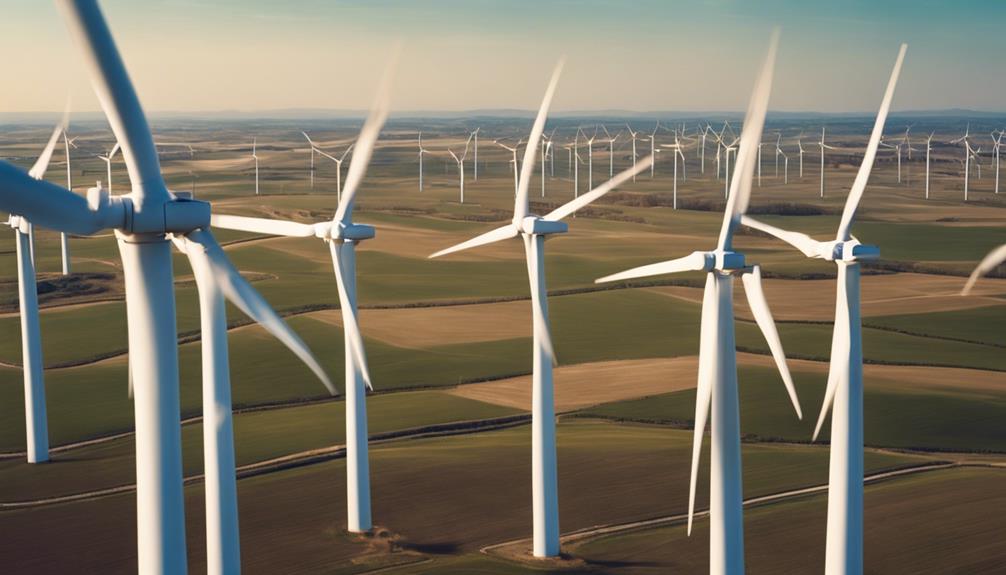
The U.S. wind industry, a significant player in the renewable energy sector, boasts a robust workforce and widespread presence across the nation. This industry has made significant strides in increasing wind capacity and creating employment opportunities.
Here are some key points to help you visualize the U.S. wind industry landscape:
- Over 125,000 individuals are employed within the U.S. wind industry, with a notable 23,543 working in manufacturing and 45,088 in construction roles.
- The United States hosts more than 500 wind-related manufacturing facilities, highlighting the industry's extensive reach and economic impact.
- Wind energy is a dominant force in the U.S., with utility-scale wind power operational in 42 states, and distributed wind power systems present in all 50 states and territories. This widespread presence signifies the industry's contribution to the nation's renewable energy portfolio.
Offshore Wind Power Details
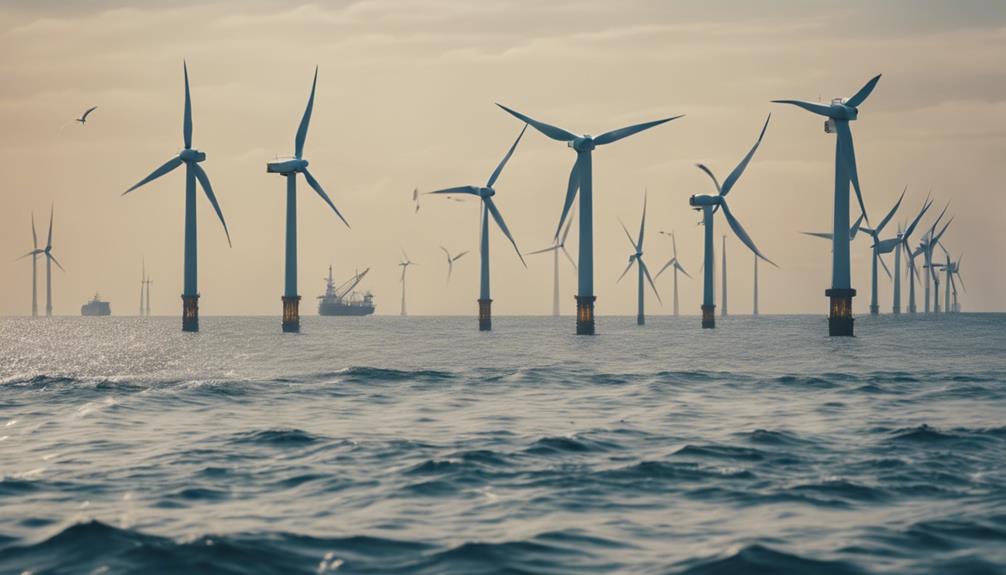
Offshore wind power has the potential to greatly contribute to meeting global electricity demand.
The faster and more consistent wind speeds at sea make offshore wind a promising source of renewable energy.
Let's explore the potential and environmental impact analysis of offshore wind in more detail.
Offshore Wind Potential
With faster and more consistent wind speeds compared to on land, offshore wind power stands out as a highly efficient energy source. Offshore wind has the potential to generate a staggering 425,000 terawatt-hours of electricity annually, playing a significant role in meeting global energy demands. Despite currently representing only 0.3% of global power generation, offshore wind capacity is rapidly growing due to decreasing costs.
Here are three compelling reasons why offshore wind power is a promising energy source:
- Offshore wind farms can produce more electricity using fewer turbines, making them a space-efficient option.
- The consistent and strong offshore winds guarantee a steady and reliable energy output.
- Offshore wind power has the potential to attract larger fish populations to the surrounding area, benefiting marine ecosystems.
The vast untapped potential of offshore wind energy presents a promising opportunity to shift towards a more sustainable and environmentally friendly energy future.
Environmental Impact Analysis
Considering the environmental impact of offshore wind power, it's important to acknowledge both its advantages and potential drawbacks. Offshore wind farms have a minor environmental impact compared to traditional energy sources, making them a more sustainable option. These structures can even attract larger fish populations, benefiting marine ecosystems.
However, there are concerns about the potential harmful effects on marine flora and fauna. The construction and operation of offshore wind farms could impact bird species and marine mammals in the area, requiring careful planning and monitoring to mitigate these risks.
Despite these drawbacks, offshore wind power remains a promising renewable energy source. It's imperative to conduct thorough environmental impact analyses before implementing offshore wind projects to guarantee the protection of marine life and ecosystems.
Additionally, it's worth noting that constructing offshore wind farms is more costly than onshore wind projects, emphasizing the need for a balanced approach to maximize the benefits of this clean energy source.
Wind Power Capacity Insights
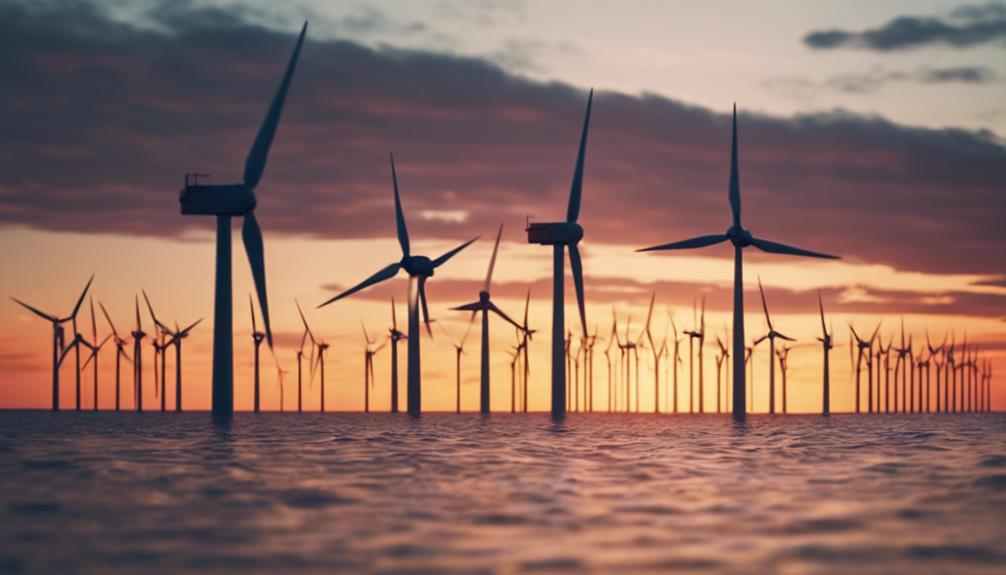
Wind power capacity in the U.S. has reached impressive levels, solidifying its position as a leading renewable energy source in the country. Here are some insights into wind power capacity:
- Over 144,000 MW Installed:
With over 144,000 MW of wind capacity installed in the U.S., wind stands as the largest renewable energy source in the nation, showcasing its substantial contribution to the energy landscape.
- 2022 Growth:
In 2022 alone, the U.S. wind industry saw an addition of over 8,500 MW of capacity, denoting a significant $12 billion investment in expanding wind power infrastructure.
- State Contributions:
Wind power plays a pivotal role in electricity generation, supplying over 20% of electricity in 12 states. Significantly, Iowa and South Dakota lead the pack with more than 50% of their electricity derived from wind energy, illustrating the substantial regional impact of wind power capacity expansion.
The continuous growth of wind power capacity across states emphasizes its essential role in shaping the renewable energy sector and diversifying the U.S. energy mix.
Wind Energy Generation Stats
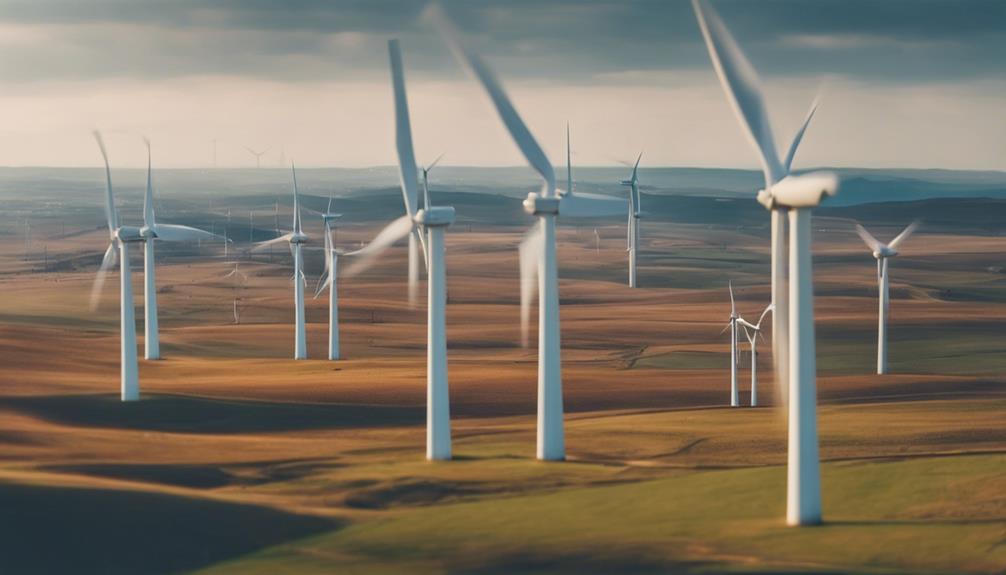
Let's explore the impressive statistics surrounding wind energy generation.
Did you know that wind power accounted for over 10% of U.S. electricity in 2022 and that Iowa and South Dakota rely on wind for more than half of their electricity needs?
The wind industry's growth is evident with over 8,500 MW of capacity added in the same year.
Wind Power Growth
The expansion of wind power in the United States has led to significant increases in electricity generation from this renewable source. As of 2022, the wind energy industry has made remarkable strides, contributing substantially to the nation's power grid.
Here are some key growth statistics that highlight the impact of wind power:
- Wind energy supplied over 10% of U.S. electricity in 2022, showcasing its growing importance in the country's energy mix.
- Wind power plays a dominant role in certain states, with over 20% of electricity coming from wind in 12 states, especially Iowa and South Dakota where more than 50% of electricity is generated from wind.
- States like Kansas, Oklahoma, and North Dakota have also seen impressive growth, producing over 30% of their electricity from wind sources. This significant shift towards renewable energy represents a $12 billion investment in the U.S., underlining the industry's substantial economic impact.
Renewable Energy Impact
With wind power playing a vital role in the electricity generation landscape of the United States, the impact of renewable energy, particularly when considering wind energy generation statistics, is worth exploring further.
Wind energy has become an essential renewable energy source, supplying over 20% of electricity in 12 U.S. states, with leaders like Iowa and South Dakota exceeding 50%.
In 2022, wind energy contributed to over 10% of the total electricity generation in the country, with more than 144,000 MW of wind power capacity installed, making it the largest renewable energy source. The industry's substantial $12 billion investment in 2022 alone added over 8,500 MW of capacity.
Additionally, the wind industry provides employment to over 125,000 individuals, with manufacturing and construction sectors contributing significantly, employing over 23,500 and 45,000 people, respectively.
The proliferation of utility-scale wind turbines installed across the U.S. underlines the positive impact of wind farms in advancing renewable energy goals.
Wind Energy Technologies Overview
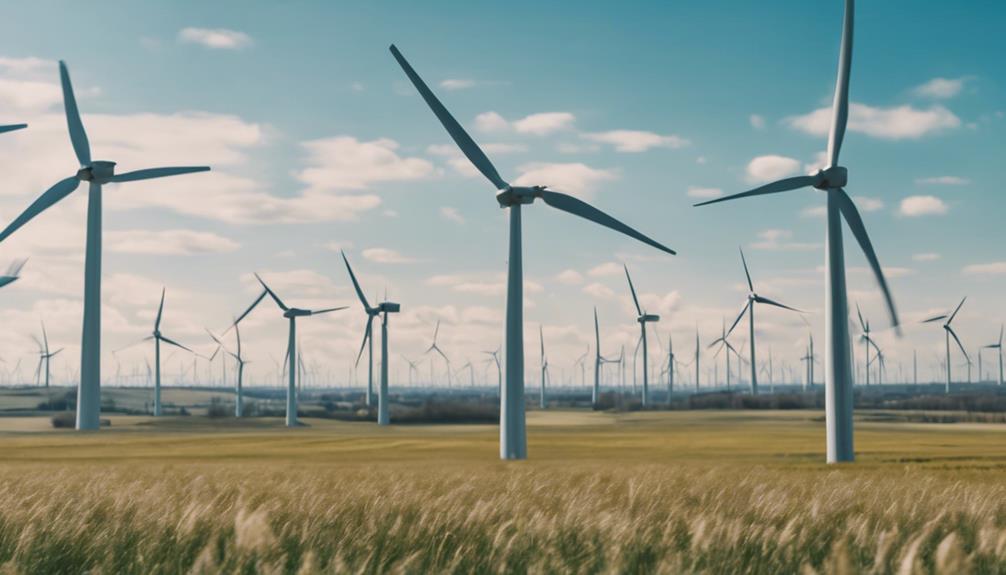
Wind energy technologies encompass a variety of innovative solutions for harnessing the power of the wind to generate electricity efficiently.
Here are some key aspects you should know about wind energy technologies:
- Turbine Power: Wind turbines are continuously evolving to become more powerful, with an average increase in nameplate capacity in 2022. This advancement allows for greater energy generation from the same amount of wind.
- Turbine Components: Each turbine consists of a multitude of components, with some turbines containing up to 8,000 parts. These intricate pieces work together seamlessly to convert wind energy into electricity effectively.
- Height and Wind Speed: Turbines are now being designed taller to access higher wind speeds, which results in increased energy production. By reaching stronger winds at greater heights, turbines can generate more electricity, making them more efficient in harnessing wind power.
Wind Power Expansion Trends
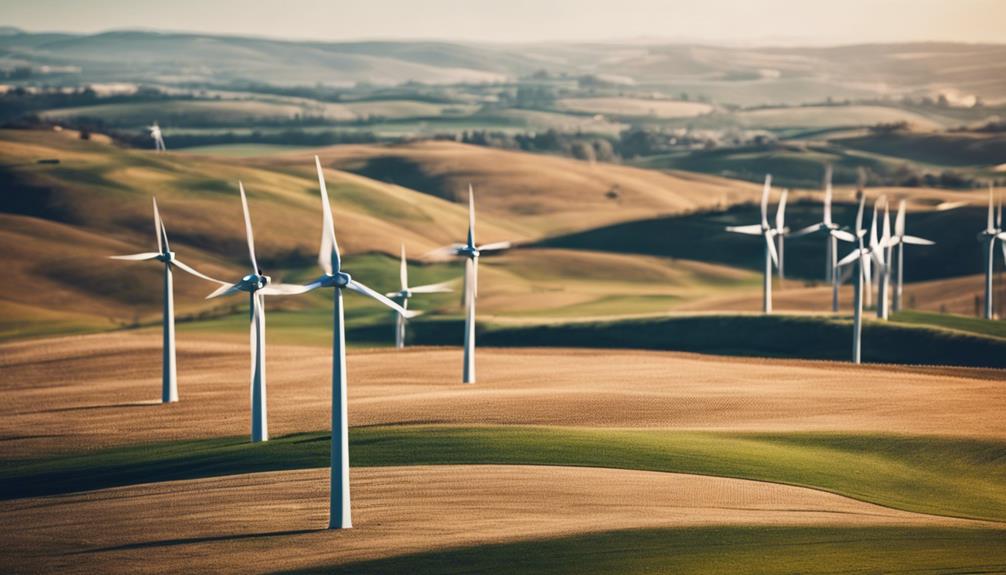
Expanding swiftly across the U.S., wind power has emerged as a pivotal force in the renewable energy landscape. With over 144,000 MW of wind capacity installed, it stands as the largest renewable energy source in the nation.
In 2022, a remarkable addition of over 8,500 MW of wind capacity was made, reflecting a substantial $12 billion investment in the industry. States have enthusiastically embraced wind power, boasting over 1 GW of installed wind capacity to bolster their energy portfolios.
The widespread adoption of distributed wind power further underscores the growth and acceptance of wind energy technologies across the country. Significantly, wind power has become a cornerstone of U.S. electricity generation, meeting more than 10% of the nation's electricity needs in 2022.
The upward trajectory of wind capacity installation signifies a promising trend towards a more sustainable and renewable energy future.
Wind Energy Investment Facts
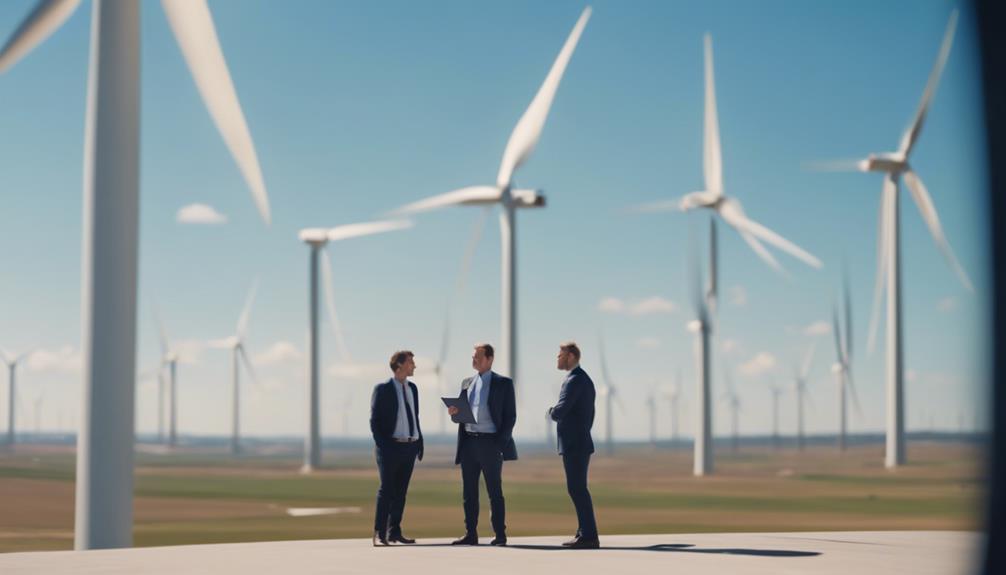
Investors consistently pour substantial funds into wind energy, making it a lucrative sector within the renewable energy industry. The wind power industry has become a hotspot for financial growth and technological advancements.
Here are some key investment facts to ponder:
- The U.S. wind industry rakes in a staggering $10 billion annually, showcasing the immense financial interest in wind power.
- Each year, wind energy adds a substantial amount of capacity, with over 8,500 MW of new capacity added in 2022 alone, representing a hefty $12 billion investment.
- Wind power contracts are sealed at competitive prices, ranging from 1.5-4 cents per kWh. This affordability makes wind energy an attractive and cost-effective option for consumers seeking sustainable energy sources.
These facts underline the robust financial backing behind wind energy and its pivotal role in shaping the renewable energy landscape.
Wind Energy Affordability Details
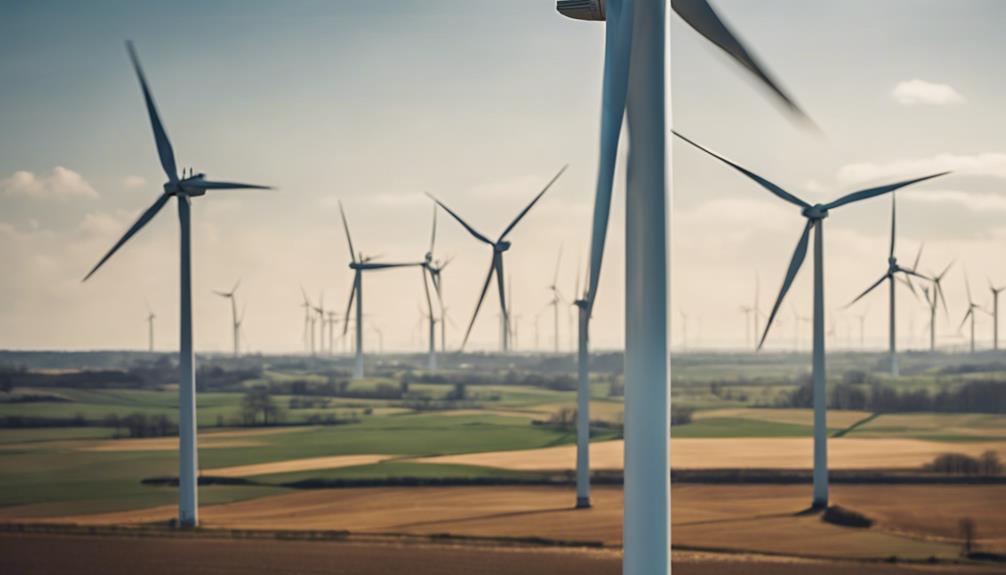
Considering the competitive prices at which wind power contracts are signed, affordability is a defining feature of wind energy. Wind power contracts typically range from 1.5 to 4 cents per kWh, making wind energy a cost-effective option for consumers.
The affordability of wind energy is further highlighted by its competitiveness with other energy sources in terms of average costs. In the U.S. alone, wind power generation represents a substantial $12 billion investment, showcasing its economic viability and importance in the energy sector.
With prices for wind energy ranging between 1.5 to 4 cents per kWh, it's evident that wind power plays a vital role in promoting energy affordability and sustainability. This affordability not only benefits consumers but also contributes to the overall goal of shifting towards renewable energy sources for a cleaner and more efficient energy future.
Frequently Asked Questions
What Do You Need to Know About Wind Turbines?
To understand wind turbines, know they're evolving tech. Blades capture wind efficiently. Towers are tall for stronger winds. Capacity rises for more power. Embrace the change—turbines are advancing for better performance.
What Is a Fun Fact About Wind?
Did you know that some wind turbines can produce enough electricity in one day to power an average household for over two months? That's the amazing power and efficiency of wind energy at work!
Why Are Wind Turbines Interesting?
Imagine a symphony of innovation and nature when you consider why wind turbines captivate. They're fascinating for their soaring blades, towering height, increasing power, and intricate design. You'll be amazed by their evolution.
What Are the 3 Pros and Cons of Wind Turbines?
When it comes to wind turbines, you'll find pros like clean, renewable energy and reduced carbon emissions. On the flip side, cons include noise, risks to wildlife, and visual impacts on landscapes.
What Safety Measures Are in Place for Engineers Working on Wind Turbines?
Engineers working on wind turbines adhere to strict safety measures to prevent accidents. They undergo thorough training on how to operate and maintain the turbines safely. Additionally, engineers memorial wind turbines by following protocols for working at high altitudes and using specialized safety equipment to minimize risks.
Conclusion
Now that you know more about wind turbines, imagine a world powered by the wind, where clean energy is abundant and accessible to all.
Just like a gentle breeze can turn the blades of a turbine, small changes can make a big impact on our planet.
So next time you see a wind turbine spinning gracefully in the distance, remember the potential it holds to create a brighter, greener future for us all.
